How Geofencing is Revolutionizing Retail Marketing in 2025
Staying ahead of the competition requires innovative strategies that resonate with tech-savvy consumers. Geofencing, a location-based marketing technology, has emerged as a game-changer in 2025, transforming how retailers engage customers, drive foot traffic, and boost sales. By creating virtual boundaries around physical locations, geofencing enables retailers to deliver hyper-targeted, personalized promotions at the right time and place. This article explores how geofencing is revolutionizing retail marketing, its key applications, benefits, challenges, and the future of this transformative technology.
What is Geofencing?
Geofencing involves setting up a virtual perimeter around a specific geographic area, such as a retail store, shopping mall, or even a competitor’s location. When a consumer’s mobile device enters or exits this predefined zone, the geofencing system triggers actions like sending push notifications, text messages, or targeted ads. This technology relies on a combination of GPS, Wi-Fi, cellular data, or IP geolocation to pinpoint a device’s location with high accuracy. Unlike geolocation, which identifies a user’s precise location, geofencing focuses on triggering actions within a designated area. For a deeper understanding of these concepts, check out this insightful comparison of
In retail, geofencing allows businesses to connect with customers in real time, delivering contextually relevant offers that align with their proximity and behavior. This precision makes it an invaluable tool for enhancing customer engagement and driving in-store visits.
Key Applications of Geofencing in Retail Marketing
1. Personalized Promotions
Geofencing enables retailers to send tailored promotions to customers based on their location. For instance, a coffee shop can send a “Buy One, Get One Free” offer to customers within a one-mile radius during slow business hours. In 2025, retailers are leveraging advanced data analytics to combine geofencing with customer purchase history and preferences, creating hyper-personalized offers. For example, a fashion retailer might send a discount on sneakers to a customer who recently browsed athletic wear online and is now near the store.
2. Driving In-Store Traffic
One of the biggest challenges for brick-and-mortar retailers is attracting foot traffic in an era dominated by e-commerce. Geofencing addresses this by enticing nearby customers with time-sensitive deals. For example, a department store might send a notification offering 20% off for the next hour to shoppers in the vicinity. This sense of urgency encourages immediate action, boosting in-store visits and impulse purchases.
3. Competitor Conquesting
Geofencing allows retailers to target customers near competitors’ locations, a strategy known as “conquesting.” In 2025, brands like Burger King have taken this to new heights, offering exclusive deals to customers near rival fast-food chains. For instance, a retailer could geofence a competitor’s store and send a coupon to shoppers, luring them to their location instead. This competitive edge is particularly effective in crowded retail environments like shopping malls.
4. Event-Based Marketing
Retailers hosting in-store events, such as product launches or seasonal sales, use geofencing to attract nearby customers. For example, during a Black Friday sale, a retailer might geofence the surrounding area to notify shoppers about exclusive doorbuster deals. This targeted approach ensures promotions reach the most relevant audience, maximizing event turnout.
5. Customer Insights and Analytics
Geofencing provides valuable data on customer behavior, such as how often they visit a store, how long they stay, and which promotions drive conversions. Retailers in 2025 are using these insights to refine their marketing strategies, optimize store layouts, and improve inventory management. For instance, a grocery chain might notice that geofenced promotions for fresh produce drive higher foot traffic on weekends, prompting them to adjust stock levels accordingly.
Benefits of Geofencing for Retailers
1. Enhanced Customer Engagement
Geofencing delivers promotions when customers are most likely to act, creating a seamless and engaging experience. By reaching shoppers at the right moment—when they’re near a store—retailers can foster stronger connections and increase brand loyalty.
2. Higher Conversion Rates
The immediacy of geofenced promotions drives quicker conversions. A 2024 study found that location-based push notifications have a 22% higher click-through rate than generic mobile ads. In 2025, retailers are seeing even better results by combining geofencing with AI-driven personalization, ensuring offers resonate with individual preferences.
3. Cost-Effective Marketing
Geofencing allows retailers to focus their marketing budgets on high-potential customers in specific areas, reducing wasted impressions. Unlike broad digital campaigns, geofencing targets users who are physically close to a store, increasing the likelihood of a purchase.
4. Improved Customer Experience
By delivering relevant, timely offers, geofencing enhances the shopping experience. Customers appreciate promotions that align with their needs and location, making them feel valued and understood.
Challenges and Considerations
While geofencing offers immense potential, it comes with challenges that retailers must navigate in 2025:
1. Privacy Concerns
Geofencing relies on location data, which raises privacy issues. Consumers may feel uneasy about being tracked, especially if they’re unaware of how their data is used. Retailers must prioritize transparency by clearly explaining data practices and obtaining explicit opt-in consent. Compliance with regulations like GDPR and CCPA is critical to maintaining trust.
2. Notification Fatigue
Overloading customers with notifications can lead to annoyance and app uninstalls. Retailers must strike a balance by sending relevant, well-timed messages. In 2025, AI algorithms help optimize notification frequency and content to avoid overwhelming users.
3. Accuracy and Technical Limitations
Geofencing accuracy depends on the quality of location data. Factors like weak GPS signals or VPN usage can reduce precision, leading to mistargeted promotions. Retailers are addressing this by integrating multiple data sources, such as Wi-Fi and IP geolocation, to improve reliability.
4. Integration Complexity
Implementing geofencing requires integration with mobile apps, CRM systems, and analytics platforms. For smaller retailers, this can be resource-intensive. However, APIs like IPstack and Radar simplify the process by offering scalable, user-friendly solutions for geofencing and geolocation.
The Future of Geofencing in Retail
As we move further into 2025, geofencing is poised to evolve with advancements in technology and consumer behavior. Here are some trends shaping its future:
1. Integration with Augmented Reality (AR)
Retailers are combining geofencing with AR to create immersive experiences. For example, a cosmetics brand might geofence a store and trigger an AR filter that lets customers virtually try on makeup as they enter, encouraging in-store purchases.
2. AI-Powered Personalization
AI is enhancing geofencing by analyzing real-time data to deliver ultra-personalized offers. In 2025, retailers use machine learning to predict customer preferences based on location, time, and past behavior, ensuring promotions are highly relevant.
3. Omnichannel Integration
Geofencing is becoming a cornerstone of omnichannel strategies, bridging online and offline experiences. Retailers are using geofenced promotions to drive in-store visits while syncing with e-commerce platforms to offer seamless shopping options.
4. Sustainability and Ethical Marketing
With growing consumer demand for ethical practices, retailers are using geofencing to promote sustainable products. For instance, a grocery store might geofence its location to highlight locally sourced produce, appealing to eco-conscious shoppers.
Case Studies: Geofencing in Action
Starbucks
Starbucks uses geofencing to send push notifications about limited-time offers to customers near its stores. In 2025, the coffee giant combines geofencing with loyalty program data to offer personalized rewards, resulting in a 15% increase in store visits during promotional campaigns.
Sephora
Sephora employs geofencing to target customers near its cosmetics stores, offering exclusive samples or discounts. By analyzing foot traffic data, Sephora optimizes its geofencing radius, achieving a 10% uplift in in-store sales.
Geofencing is revolutionizing retail marketing in 2025 by enabling retailers to deliver personalized, timely promotions that drive in-store traffic and enhance customer engagement. Its ability to target customers based on their physical location offers unmatched precision, making it a powerful tool in the competitive retail landscape. While challenges like privacy and notification fatigue persist, advancements in AI, AR, and omnichannel integration are unlocking new possibilities for geofencing. By adopting this technology responsibly, retailers can create meaningful connections with customers, boost conversions, and stay ahead in the ever-changing world of retail.



